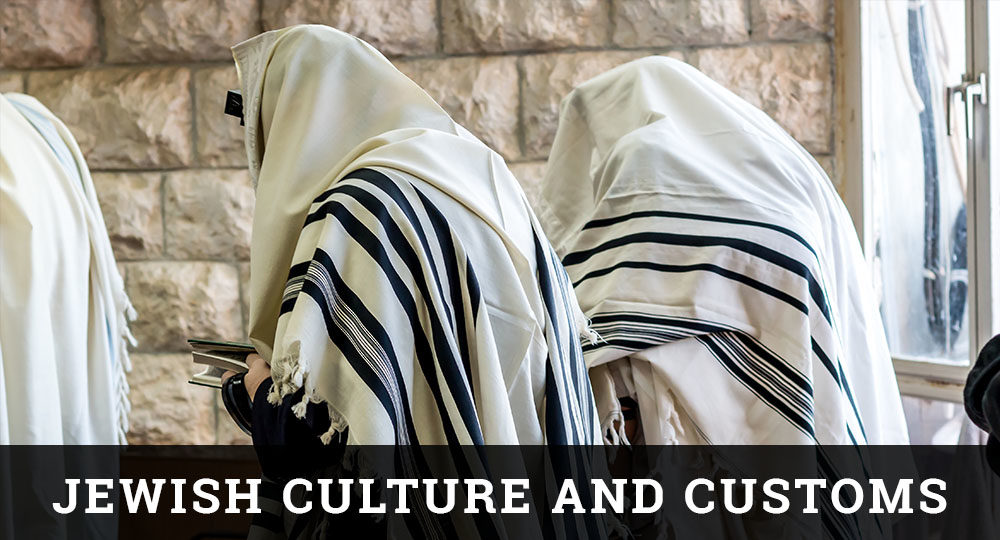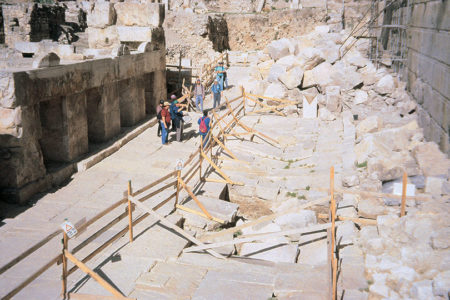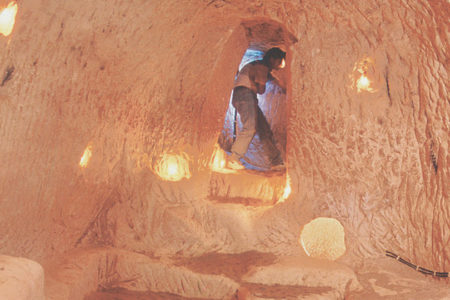Workmen’s Circle
The children of Israel provided an interesting name for the heavenly bread sent to them from the Lord. They called it manna, which means “What is it?” (Ex. 16:15). The same question is asked today when people hear the name of an organization called Workmen’s Circle. Despite a national membership of about twenty thousand, most Jewish people, like their wandering brethren of the past, wonder, “What is it?”
The name was familiar in my household, but as a youngster I could never really grasp what the organization was all about. I knew it was a Jewish association to which some of my family belonged. If I asked about it, the only answer I ever got was, “It is not Communist!” That was certainly good news. But the organization has much more going for it than the mere fact it isn’t Communist.
Workmen’s Circle was started more than a hundred years ago by Yiddish-speaking Jewish immigrants who were trying to make America their home. My Uncle Sam was a committed member for more than fifty years, devoting countless evenings to serving on many of the different organizational committees. He also offered his carpentry skills free of charge when they were needed for any of the many Workmen’s Circle projects. When he passed away eighteen years ago, there was no question that my aunt would maintain the $75 yearly membership fee. Her reasons to do so were many, not the least of which was that, upon her death, she would be assured of being buried next to her husband in a Workmen’s Circle cemetery. That is one of the many benefits of being a member in good standing, and it brings my aunt much comfort. Nor is she alone. For more than a hundred years the attraction to Circle membership has been the security its many benefits provide.
Workmen’s Circle began on the Lower East Side of New York City in 1892. It was nationalized in 1900, holding its first convention in 1901. By 1905 the organization had grown to 6,776 members. That number increased dramatically to 45,666 by 1913 and just twelve years later reached its all-time high of 87,000. What moved so many in such a short time to become so attracted to this organization?
The Goldenah Medinah
Most, if not all, of the Circle’s early members were socialists. That fact is not surprising since they had come largely from Eastern European countries where terrible anti-Semitism afflicted them night and day. Eventually it drove them out and brought them to the United States.
In Russia, where Jewish people were ruthlessly slaughtered in government-sanctioned persecutions called pogroms, socialism seemed far more attractive than the brutal rule of the czar. Workmen’s Circle (in Yiddish, Der Arbeter Ring) began in the midst of the largest immigration of Jewish people to the United States. Some two million Jews made the difficult journey between 1883 and 1917.
After arriving in America, they were processed through Ellis Island off the shores of New York City. Then many boarded nearby trains and set out for other parts of the country. There they hoped to realize their dreams in what they called in Yiddish, the goldenah medinah—the “golden land.”
Thousands, however, stayed in New York City, daring to dream there. For most, life in the goldenah medinah turned out to be a struggle for survival in the tenements of New York City. To survive in a new country with a new language and few resources was difficult. But these Jews, most of them young, brought two strong convictions with them from the Old Country. First, as secular socialists, they were freethinking and tough but possessed enough humility to realize survival meant working together. Second, they were fiercely determined to maintain their Jewish identity.
Dr. Emanuel S. Goldstein, professor of Yiddish at Queens College, stated it this way: “The real raison d’etre of Workmen’s Circle became the fight against assimilation.”1 Yiddish, the language of most Jews in Europe, became the language of most Jews in Workmen’s Circle. At first they used it almost exclusively. Their slogan, “a shenere un beserevelt”—“a more beautiful and better world”—nicely characterized the organization’s purpose. In the words of its current president, Robert Kestenbaum,
The essence of the Workmen’s Circle/Arbeter Ring’s dedication to Jewish community, Yiddish culture and social justice is not simply a tag line printed on a letterhead. Rather, it is a way of life and the fundamental reason we and others like us exist. The pursuit of a shenere un beserevelt, a better and more beautiful world, serves as a call for all to adopt in their own way to fulfill personal and collective responsibilities.2
With an understood objective of providing mutual aid and assistance to those of like mind and circumstance, Workmen’s Circle provided the additional benefits of camaraderie and friendship. Membership brought people together. Before networking became a familiar business term, members of the Circle did it, not to get ahead but because it was a good thing. As a result, membership increased rapidly.
Social Services
Cash gifts. The life of a new immigrant was difficult. Even if it was only a few dollars, a monetary gift was an incredible help to a stranger starting off in America. Many Jewish people can tell you how a $5 or $10 bill donated from the Circle gave them their start.
Union Involvement. When immigrants arrived in America they needed jobs. In those days working conditions were poor; the hours, long; the pay, low. There were no laws or unions protecting workers against employers who wished to take advantage of them. With its strong commitment to labor, Workmen’s Circle worked to end sweatshops, organizing when it became necessary and even boycotting businesses when expedient to apply the financial pressure needed to change conditions. In many cases this pressure worked. To this day, the Circle still works hard to support labor and social justice.
Medical Care. Today most people have access to medical care, which is almost regarded as a national right. In the early days of the Circle, it established medical clinics for its members. Thousands of people used them for decades. When these clinics finally were forced to close because of finances, the Circle offered health insurance in their stead. For the many who have benefited from this program, “a better and more beautiful world” became a reality.
Homes for the Aged.Who among us does not have a concern about the senior season of life? It can become an overwhelming consideration. Workmen’s Circle makes it possible to alleviate that concern. Its homes for the aged have met a tremendous need over the years.
Cemeteries. Workmen’s Circle provides cemetery plots for members—like my aunt and uncle.
Education. Jewish immigrants brought with them a respect and desire for good education. For more than seventy-five years the I. L. Peretz schools have helped children “establish kinship with their Eastern European culture and Jewish people worldwide.”3 These schools, called shulnin Yiddish, offer a wide range of subjects. In fact, they constitute “the largest network of Jewish secular schools in the United States.”4 They reached their peak enrollment in 1950 with 38,000 Jewish students.
Existing all across the country, these schools have high standards and a demanding curriculum. Originally teaching almost exclusively in Yiddish, today they emphasize Yiddishkite (Jewish culture), which they believe will help Jewish children stay close to their roots. Although enrollment has declined over the years, several thousand students still attend these schools nationally, with about 550 in New York City alone.
Adult education classes also are offered to help expand minds as well as opportunities in America. And no education would be complete without good books. Workmen’s Circle boasts a unique collection of Yiddish-language and other Jewish books, as well as reference works designed for serious study in Jewish history, literature, and culture. Appointments can be made to access the collection. Members receive a regular mailing from the Circle, which regularly recommends books the leadership feels will enhance quality of life for its people.
Cultural Activities
In addition to operating schools during the academic year, Workmen’s Circle also operates camps called Kinder Rings to provide children with wholesome recreation during the summer and foster a sense of pride in their identity as Jews.
Cultural pursuits historically have been important in the lives of the Jewish people. Workmen’s Circle still promotes Folksbiene (Yiddish theatre).
It also has provided many opportunities for its members to access the kinds of entertainment that will not only entertain but tap into the rich heritage of the Jewish people. The organization’s Web site states, “Singing timeless melodies in Yiddish and other songs known to Jews throughout the world, our choruses perpetuate our legacy as they expand their musical repertoires.”5 During the summer season Yiddish folksongs are performed publicly in parks where no admission is charged.
Workmen’s Circle has been a great help to the Jewish community. Consistent with the Torah’s commandment, “Thou shalt love thy neighbor as thyself” (Lev. 19:18), Workmen’s Circle has provided members with mutual aid and health and death benefits and has aligned itself with Jewish unions in an effort to help working-class Jewish people and with a Yiddish newspaper (The Forward) in an effort to inform and educate.
Christians can glean a great deal from humanitarian organizations like this one so that we can minister to people of like precious faith. Providing a measure of security for people is a good thing. But dependency on people must never supersede dependence on God. My aunt has maintained her membership in Workmen’s Circle for many years and is thrilled to know that someday she will lie next to her husband in their Workmen’s Circle plot. More important, however, is the fact that eight years ago, at eighty years of age, she placed her faith in her Messiah for the security of an eternal place in heaven.
ENDNOTES
- Joseph Berger, “Less Socialist but Still Social,” The New York Times, Metro Edition, October 31, 2002, B6.
- Robert Kestenbaum, “Let Social Justice ‘Ring,’” [www.forward.com/issues/2002/02.11.08/oped2. html], November 8, 2002.
- “The Workmen’s Circle, Arbeter Ring,” [www.circle.org/wccjl.html].
- Encyclopaedia Judaica, CD-ROM Edition, s.v. “Workmen’s Circle.”
- “The Workmen’s Circle, Arbeter Ring,” [www.circle.org/wccjl.html].








Went to Camp Hofnung for a week or two one summer during late 30’s or early 40’s. Lived next door to a Workman’s circle meeting place near 31st and Dauphin Street, in Philadelphia, during the 40’s and 50’s.
Interested in any information you can provide about Camp Hofnung or the Worker’s Circle Building at 31st and Dauphin Street.
Jack Shore